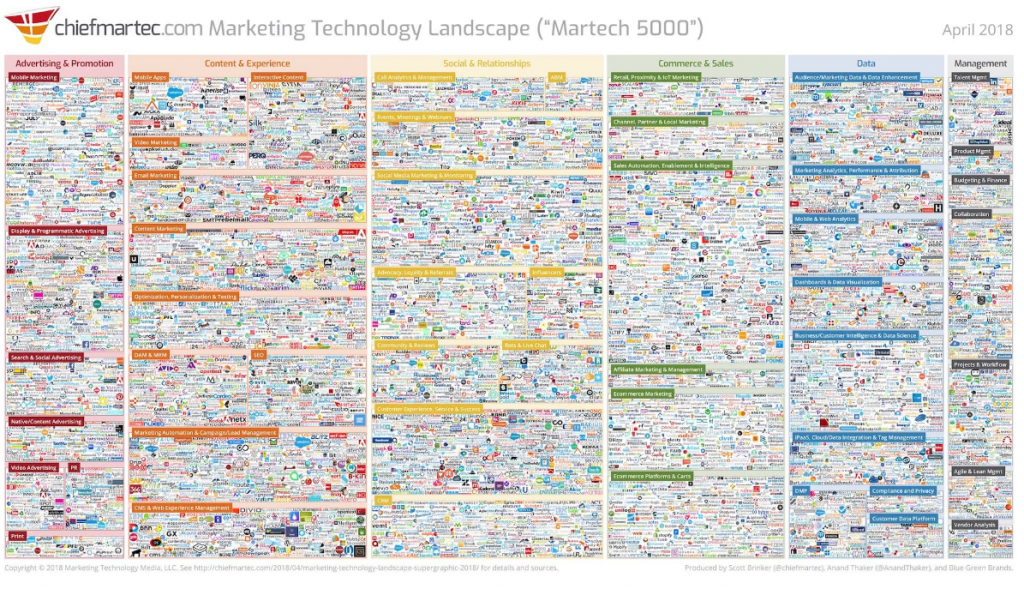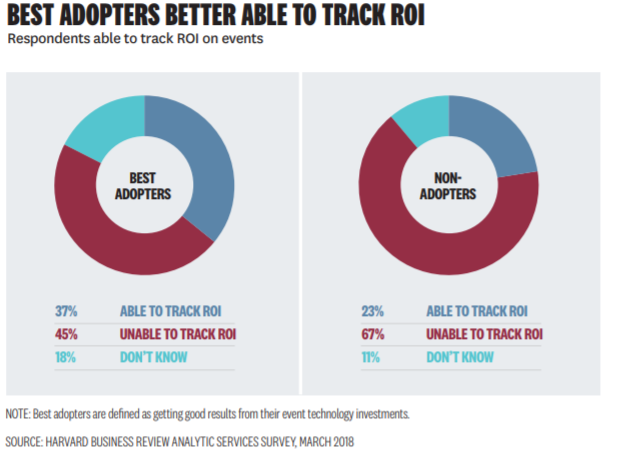
One of the million dollar questions in event marketing is “how do you attract attendees”. To try and answer it, we’ve created The B2B Event Marketing Guide, a 15 chapters report on the full marketing strategy and planning process that goes behind a business event.
The article below is an excerpt from the guide. Find the other chapters here.
In this section: The marketing tech stack and what objectives it can help achieve. Building your tech stack from 0 and deciding where to invest in. Performance indicators for event marketing tech stack.
The amount of marketing technology available is staggering (and a bit frightening, if we’re honest). Just look at this:

If you zoom in, you’ll see around 5,000 providers from different areas (or you can browse them here). And this was in 2017, with the number increasing to over 7,000 in 2018. How do you choose which technology to use can be a difficult task, so let’s see how you can simplify it.
Let’s take a look at the big categories for marketing tech:
– Advertising & Promotion (Mobile, Display & Programmatic, Search, Social, Video, PR, Print)
– Content & Experience (Email Marketing, Content Syndication, Personalisation, Testing, SEO, CMS, Campaign Management, Marketing Automation)
– Social & Relationships (ABM, Webinar Platforms, Call Management, Influencers, Social Media Monitoring, Referrals Platforms, Live Chats, Customer Experience, CRM)
– Commerce & Sales (Proximity, Channel, Sales Automation, Affiliate Marketing, Ecommerce)
– Data (Audience Enhancement, Marketing Analytics, Web Analytics, Business Intelligence, Cloud Integration, Compliance)
– Management (Talent, Product, Reporting, Collaborations, Workflow, Vendor)
What objectives does the tech stack help with?
These can help achieve several goals:
1. Provide data for better decision making – for example, a CRM will show you who are your bigger spenders and what are their favourite channels
2. Improve efficiency of marketing channels & spend – for example, a search marketing platform will reveal the best performing ads and ideal budget allocation
3. Improve customer experience – for example, an automated registration platform will provide a better experience for attendees compared to them having to email all the details to you, so you can add them on a spreadsheet
4. Automate repetitive processes to save time for the marketing team – for example, sending automated reminder emails to registered attendees
Depending on your needs, your money, time & human resources, you will decide which platforms to start using. Since these will help you achieve your marketing objectives, you will first have to build your marketing strategy, then decide which parts of it can be optimized with a tech stack.
Plus, this will also help you review the budget you have available. Whilst some resources are free, setting them up and learning how to run them will still require time. Also, in order to be effective, they will have to respond to your needs and integrate with other tech platforms you’re using, which makes it even more time consuming to research the right alternatives.
However, increased efficiencies will make it all worth it. Reports claim that marketers using automation software generate 2X the number of leads than those using blast email software (source) and that event technology can help increase event attendance by 20%, increase productivity by 27%, and decrease costs by 20-30%. (source)
Building your tech stack from 0
If you’re tech stack is 0, we recommend you start investing in tools that improve customer experience. A registration form or an event app will provide a better interaction with your brand for attendees and happy customers are more likely to return. Then, once you’ve set the base for better customer experience, we would recommend investing in a CRM.
There are free options available too for small companies, though some functionalities may not be available in the free solution. A CRM will give you insight into customer lifetime value, what events of yours they have attended in the past, what emails they’re clicking, what they’re saying on social media, etc.
Couple this with ABM or social listening tools and you have a great amount of data on your customers, which can help you optimise your channels, tailor your messaging and increase revenue for your target audience. Here is a review of CRM systems.
Once you’ve started using technology to increase efficiency on your channels, marketing automation will help automate repetitive tasks and give you more time for strategy and creativity. You can automate emails, social posting, lead scoring, lead nurturing, ad campaigns – you name it.
Performance indicators for event marketing tech stack
Tools will help you schedule, test and optimise, so you will have to focus on reviewing performance and investing in what brings the most ROI. Here’s a list of marketing automation software that can make your life easier.
Proving ROI of marketing tech isn’t always easy. A report done by Kapost mentioned that 43% of B2B marketers don’t know how much revenue they help generate (source), so this makes it even more difficult to calculate of ROI of the tech stack. Kapost identifies 5 revenue attribution models:
1. Converting leads faster than before using the tech stack
2. Productivity gains in content production (faster, more and higher quality)
3. Productivity gains for internal teams
4. Productivity gains in workflows & team alignment
5. Cost reduction with agency spend
The good news is that the better your tech stack performs, the more you can track ROI for your events:

Key takeaways: Align your tech stack to your marketing strategy and to other technologies you’re using. Ensure you constantly track results, so you can then justify ROI.
If you’re interested in The B2B Event Marketing Guide, fill in the form below to download it:

